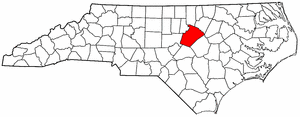Holly Springs: The Community

(Source: Wikimedia.org)
Holly Springs was founded in the early 1800s and incorporated in 1876. The town remained small throughout much of the next century, as World War I and the Depression limited prosperity, and many young people left in search of employment opportunities. A 1984 study found that Holly Springs lacked modern housing, grocery stores, schools, health care, and employment, and about one-fourth of the residents were living in poverty. In 1987 the town constructed a sewer system, which provided the necessary infrastructure to attract industry and spur growth. In 1990, Holly Springs had a population of 908 people, and 78% of the residents were Black. Between 1990 and 2000, Holly Springs’ population grew to 9,192 people; many of these newcomers were wealthy and White. By 2000, Black residents made up only 19% of the total population.
The Holly Springs area makes up about 1% of the total land area of Wake County, but 13% of the county’s landfills have been sited there. The Holly Springs area is the location of ten permitted solid waste facilities (including three closed facilities and the new facility) on eight sites. These include construction and debris landfills and a waste transfer station. Nine (90%) of these facilities are located within predominantly Black communities. Two of the three inactive landfills received hazardous waste while they were operational.
Profile of Holly Springs compared to North Carolina (2000 data)
|
|
Holly Springs |
North Carolina |
|
Population |
9,192 |
8,049,313 |
|
% Black |
19% |
22% |
|
Median income |
$69,550 |
$39,184 |
|
Unemployment |
1.7% |
3.4% |
|
High school education or more |
92% |
78% |

